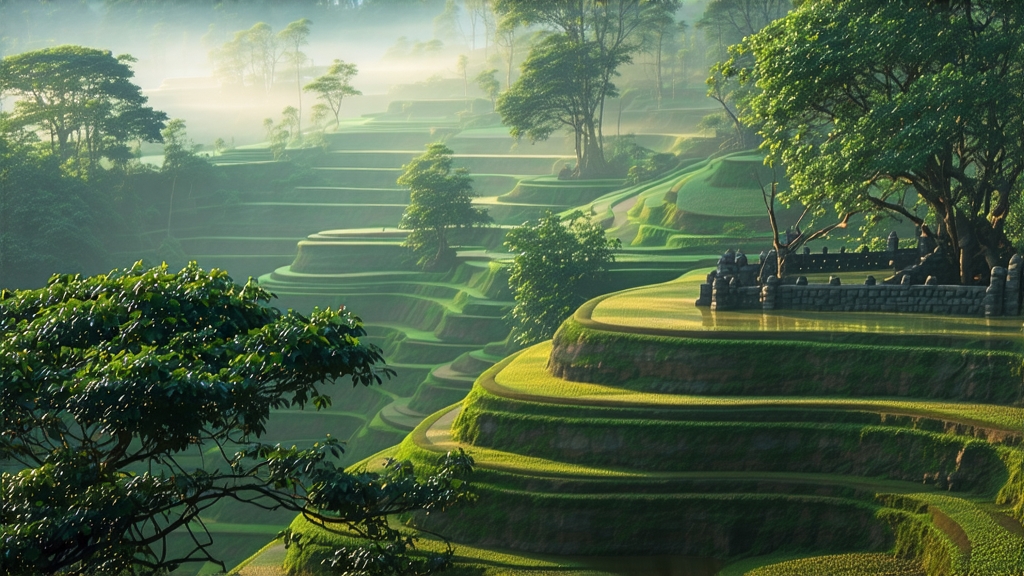
High above the East River, where granite peaks tear through subtropical cloud, the Phoenix Mountains of Guangdong guard one of China’s most aromatic secrets—Phoenix Dancong. Literally “single-bush,” Dancong once meant that every tree was so genetically unique it was harvested, withered, and fired individually, like a soloist performing an unrepeated melody. Today the term is softened: small garden blocks of clonal descendants still preserve the old Song-era trees as living libraries of scent. Yet the romance remains; each leaf can still translate mountain mist, mineral cliff, and flower into a liqueur that changes with every steeping.
History whispers through these slopes. During the Southern Song dynasty (1127-1279), imperial refugees fleeing the Jurchen north carried tea seeds into Feng Huang Shan. Monks planted them in crevices too narrow for rice but perfect for tea, where poor, stony soil forced roots to dive three metres in search of water, concentrating aromatic oils. By the Ming, local gazetteers record “bird-beak” tea so fragrant that county magistrates sent it as tribute. European traders first tasted it in the 18th-century port of Canton, confusing it with Bohea and naming it “Oonfa” in logbooks—an early phonetic ancestor of “oolong.” The 1980s economic liberalisation revived heirloom gardens; today Phoenix Dancong enjoys Protected Geographical Indication status, and ancient mother trees are insured for millions of renminbi, yet still belong to individual families who climb barefoot to tend them.
Botanically, Dancong is not one cultivar but a perfumed orchestra of over eighty recognised aromatic profiles, each preserved by grafting and air-layering. Gardeners classify them by the dominant fragrance they mimic—Honey Orchid, Almond, Ginger Flower, Yellow Gardenia, Night-Blooming Jasmine, even Sweet Potato. The most prestigious is “Song Zhong,” offspring of the 900-year-old Song dynasty tree still living on Wudong peak; its infusion layers lychee, pomelo zest, and a cooling camphor finish that lingers like mountain wind. Lesser-known gems such as “Eight Immortals” or “Eternal Source” offer sesame-nougat depth or magnolia brightness, turning each session into a guessing game for the nose.
Crafting Dancong is a dialogue between fire and air that stretches across thirty-six hours without rest. Picking starts at dawn when two leaves and a bud still hold dew; any later and the sun burns off the volatile aromatics. The pluck is spread only one leaf deep on bamboo trays set inside the cliff-side tea shed, where mountain wind replaces electric fans. Four rounds of solar withering alternate with shade; edges bruise against wicker racks, initiating oxidation that climbs in tiny increments—ten percent, twenty, never more than thirty—so the green heart remains while red veins thread the leaf like mineral in jade.
The turning point is the midnight charcoal firing. Using only lychee wood that burns long and scent-neutral, the tea master heaps embers into a waist-high pit, covers them with a perforated iron sheet, then piles leaves in bamboo cylinders no thicker than a forearm. For eight hours he never sleeps, rolling the cylinders every fifteen minutes so the leaf unfurls, tightens, and caramelises without baking. Between firings the tea rests, breathing through the porous bamboo, absorbing lychee smoke so subtly that only a trained palate detects it. By dawn the leaf has shrunk to half its weight, twisted into dark, snail-like strips that rattle when poured—an auditory test of proper dryness.
To brew Phoenix Dancong like a local, forget teapots; reach for a gaiwan whose thin porcelain amplifies aroma. Pre-heat with 95 °C water, then fill the bowl one-third full—roughly five grams—for the leaf must touch the lid. The first flash rinse is discarded, not to clean but to awaken; the second infusion, only ten seconds, releases a golden liquor that smells like warm apricot skin. Subsequent steeps lengthen by five-second breaths: fifteen, twenty, thirty. A good Dancong yields twelve rounds before surrendering, each revealing a new verse. The third is often the most dramatic, when tannins balance sugar into a nectar that coats the lips. By the seventh, mineral notes emerge—wet slate, river stone—proof of the granite substrate. Locals invert the gaiwan lid between steeps and invite guests to sniff